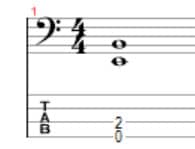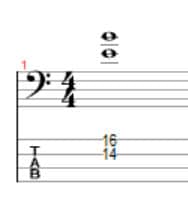Playing chords on the bass quickly makes it apparent why it’s usually played one string at a time. It’s hard to make out the individual notes, and it sounds like an unorganized mess. But why does this happen on the bass and not the guitar, and why do bass chords sound muddy?
Chords sound muddy on the bass because it is a low-frequency instrument. Intervals are closer to one another in frequency at deeper frequencies than at higher ones and are thus harder to distinguish. When intervals are undistinguishable we are unable to hear their harmonic foundation, which makes us perceive them as muddy.
It doesn’t help that many bassists prefer fuzzy, distorted, or boomy tones. While this doesn’t strictly make chords sound muddy, it does make it more difficult to hear them clearly.
But why does this lead to low chords sounding so bad, and how can you play chords on the bass despite this? I`m about to show you. I’m also going to give you a cheat sheet for playing chords on the bass without them sounding muddy ever again.
Why do low chords sound bad?
Intervals are closer to each other in frequency at deeper pitches. The closer intervals are in frequency, the harder it becomes to distinguish them when played together as a chord.
As an example, let’s look at a power chord played in two different ways on the bass:
The open E on a 4-string bass is 20.6hz while the B above it on the A string is 30.87hz. They are 10.27hz apart in frequency.

When playing the E on the 14th fret of the D string and the B on the 16th fret of the G string, the chord is played two octaves higher. Here, the E is 82.41hz, and the B is 123.47hz. They are now 41.06hz apart.

This makes the difference in frequency between the E and B quadruple. As a result, the chord sounds significantly clearer when played higher. If you have your bass close by, try playing both examples and listening to the massive difference in clarity.
Sounds at lower frequencies have a longer wavelength. Longer wavelengths give our ears more time to hear the interference between the notes in the chord.
Chords at higher pitches have a shorter wavelength, which results in fewer spots for us to hear interference. The notes in the chord are in synch with each other more often, and thus it sounds clearer.
Thus, as the bass generally sticks to the lower register when playing grooves, it becomes difficult to incorporate chords without them sounding muddy. This is because the intervals of the chords will be close in frequency and hard to distinguish. As a result, our ears will perceive them as muddy.
It is for this reason, that while bassists play chords, they often do so one note at a time instead of strumming them.
Lower interval limit
The lower interval limit is a concept that gives a range for how low intervals can be played, while still sounding distinguishable.
Some intervals, such as the perfect 5th are more distinguishable at lower frequencies than a minor second. This is affected by the difference in frequency of the intervals and the harmonic relationship of the interval.
For a bassist, being conscious of lower interval limits is extremely beneficial for playing chords.
You will find every low interval limit within the range of the 4-string bass. Thus, you can play every interval on the bass, but how deep you can play them without sounding muddy will vary.
Thus, being conscious of lower interval limits will help you understand what chords you can play where on the neck. This will help you avoid playing muddy-sounding chords, and help you notice spots where you can incorporate chords you normally wouldn’t think of.
Some people have better pitch and harmonic understanding than others. Therefore, there isn’t a universal agreement about what the lower interval limits are. However, the ballpark is generally agreed upon and most people will perceive it similarly.
Here is one interpretation of what the lower interval limits are. Chords might still sound muddy to some when played close to the lower limit, but they will sound muddy to almost everyone if you go below them:
| Interval | Lowest interval limit |
| Minor 2. | E2 – F2 |
| Major 2. | Eb2 – F2 |
| Minor 3. | C2 – Eb2 |
| Major 3. | B1 – D#2 |
| Perfect Fourth | A1 – D2 |
| Tritone | B0 – F1 |
| Perfect fifth | C#1 – G#1 |
| Minor 6. | F1 – Db2 |
| Major 6. | F1 – D2 |
| Minor 7. | F1 – Eb2 |
| Major 7. | F1 – E2 |
How do you make bass chords sound good?
Bass chords sound the best as power chords that only use the root and 5th notes of a chord. Furthermore, bass chords sound less muddy at higher pitches. Voicing chords higher will thus make chord notes such as the 3rd and 7th sound clearer.
When playing at deeper ranges it`s often best to stick to power chords when strumming the bass.
As you progress up the neck, you can start introducing 3rds and 7ths. They tend to be less clear than fifths, but they also provide a lot of harmonic identity to your chords. To learn more, check out my article on easy bass chords for beginners.
You should also make good use of the table of lower limit intervals above. It`s best to listen for yourself whether your chords sound muddy or not, but as a rule of thumb, it`s best to not play chords below the lower limit intervals.
Whether a bass chord will sound good also depends on what type of music you are playing. In metal, there are generally two distorted guitars that are already creating a heavy soundscape, which makes it harder to incorporate chords for a bass player.
In smaller funk bands the bass has a lot of room to be groovy and creative. Thus, depending on the band, there will generally be spots where chords can sound appropriate.
For a great example of bass chord usage, listen to the intro of the song below. It`s called “A better place, a better time”, by Streetlight Manifesto and showcases how bass chords can start a song in a beautiful manner.
Conclusion
Bass chords sound muddy for a scientifically explainable reason. When a chord is played deep enough, it becomes humanly impossible to distinguish its notes due to their long wavelengths and being too close in frequency.
Extensively deep chords should be avoided unless you want them to sound muddy for artistic reasons.
Higher up on the neck chords become gradually clearer. However, different intervals become comprehensible at different frequencies.
Lower limit intervals dictate where on the bass you can start thinking about playing what chords. Chords can still sound unclear while staying above these limits, but going below them guarantees that they will sound muddy.
Bass chords have their time and place but are best used sparingly. You will do much better as a bassist if you get good at hearing spots where chords could fit, rather than trying to force them into your bass lines.
A great way to start incorporating chords is to check out this bass chord chart I made. It works as a great introduction to learning bass chords and also has some further tips on how to prevent them from sounding muddy.

